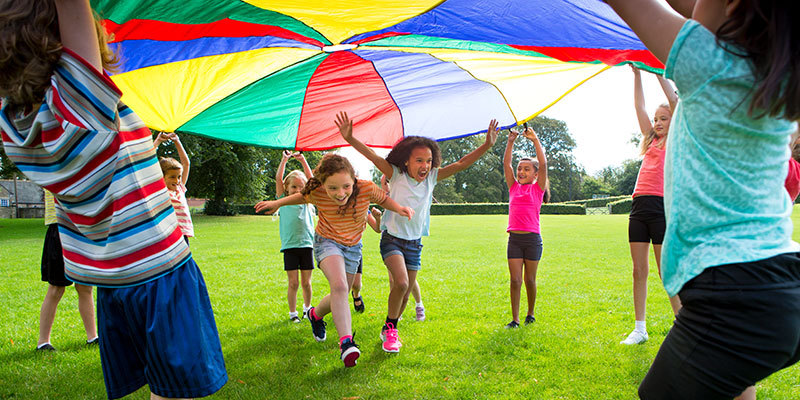As all PE teachers know, Physical Education is not just about playing games and getting kids to move; PE teachers also have the tremendous responsibility of building the foundation for healthy physical activity and a positive body image. Let’s not forget, PE teachers must engage their students in authentic, motivating lessons that will build their physical literacies while developing skills in the three domains of learning and health-related fitness (psychomotor, cognitive, and affective). With all of that in mind, where do we begin?
First, let’s take a look at each of the three domains of learning within physical education. After reviewing the domains, we’ll analyze grade-specific PE lessons that you can use as models to seamlessly incorporate each domain into your PE instruction.
Psychomotor Domain (Body)
The psychomotor domain refers to the physical aspects of learning. It addresses motion, reflexes, and how muscles are engaged during physical activity. In your PE classes, you can help students build a number of psychomotor skills, including reflexive skills, perceptual abilities, and complex, higher-order skills that require a combination of physical abilities to yield a motion.
Cognitive Domain (Brain)
The cognitive domain addresses the development of content knowledge and intellectual skills. Teaching and learning in the cognitive domain is essential to PE, as without it, students are less likely to understand rules or develop strategies to excel in activities, sports, and games. You can use Bloom’s Taxonomy as a tool to build students’ knowledge of healthy movements.
Affective Domain (Feelings)
The affective domain focuses on students’ feelings, attitudes, and values about movement. Learning in this domain is difficult to measure because it takes place internally. However, you can use the Bloom’s Affective Taxonomy as a guide to observe your students’ learning. For starters, focus on a student’s ability to pay attention and place value on the importance of movement.
To learn more about each of the domains of learning and health-related fitness, visit this link.
Now, let’s review some grade-specific PE activities and reflect on how the learning domains are implemented. These general activities do not focus on specific PE units and can be implemented at any point throughout the school year or as warm-ups at the beginning of class.
Grades K-2: Line Boogie
In this activity, students line up in groups and move a beanbag from one end of the line to the next without letting it hit the floor. For an added element, you can incorporate music. When the music runs out, the team who has moved the beanbag furthest down the line is the winner.
Psychomotor
Students develop hand-eye coordination, reflex skills, and foundational movement patterns as they transfer the beanbag down the line, catch it to prevent it from falling, and race from one end of the line to the other.
Cognitive
Students analyze which seating positions and strategies will most effectively and quickly move the beanbag down the line (e.g., overhead, side-to-side), and they apply and modify these techniques as they progress through the challenge.
Affective
In order to perform well in this challenge, students must pay attention to their teammates’ movements and place value on the importance of preventing the beanbag from hitting the floor.
Grades 3-5: Tic-Tac-Toe Relay
Students form teams to compete in a tic-tac-toe relay race. Students race from one end of the gym to the next, placing their team’s marker on the tic-tac-toe board. They then race back and tag their teammate, who then races across the gym to place a marker on the board, and so on. The object of the game is to make a row before the opposing team does.
Psychomotor
Students execute line drills; they work on speed, control, and balance as they quickly move to the tic-tac-toe board and pivot to run across the gym.
Cognitive
Students evaluate the best place to put their marker. In many cases, they will have to predict where their opponent will put the marker first and anticipate how to block the next opponent from making a row.
Affective: Students challenge themselves to race to the end of the gym as quickly as possible, choose the best place to put their marker, and block their opponents from winning the game. In order to perform well in this activity, students need to place value on their contribution to the team.
Grades 6-8: Moving Tower Push Ups
Students rebuild a tower by moving each piece to the left without placing a bigger object on a smaller object. The kicker is, they can only make one move at a time. In between moves, they must run to a designated spot and complete a push up to the best of his/her ability.
Psychomotor
This is an excellent way to teach students how to effectively execute a push up. Students need to complete a proper push up, race to one end of the gym, run backward, and repeat.
Cognitive
Students evaluate how to recreate the tower in as few steps as possible. They must also assess their push up technique and modify their movement when necessary in order to keep participating in the activity even after it becomes physically difficult.
Affective
Students challenge themselves to race to the end of the gym as quickly as possible, show tolerance for the pain of a push up, and persevere despite challenge and difficulty.
High School Students: Wacky Walks Heart Rate Monitoring
Students learn how to take their resting and active heart rates. They then practice a variety of walking techniques (e.g., walking lunges and high knees) and take their heart rate after completing each movement. Students also perform a series of triceps dips and push ups to see how their heart rate is affected by using different muscle groups.
Psychomotor
Students reproduce activities based on their teacher’s instruction; they work on balance and precision as they execute each new movement; they master the ability to switch between movements; and they engage a variety of muscle groups.
Cognitive
Students learn how to take their heart rate; they analyze how movement affects their heart rate; and they compare and contrast the differences a variety of movements have on the rise and fall of their heart rate.
Affective
Students develop an understanding of the importance of exercise and which activities will best increase their heart rate in order to get the most out of their workouts.






